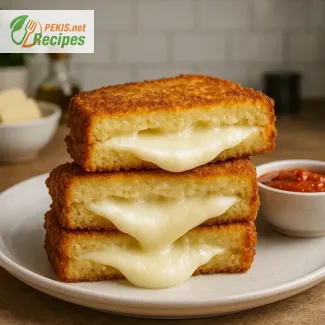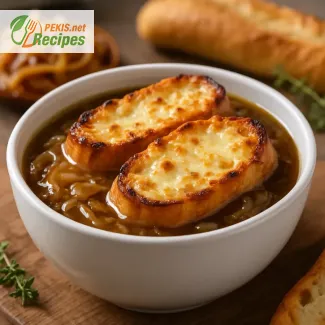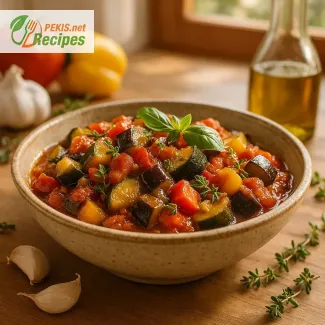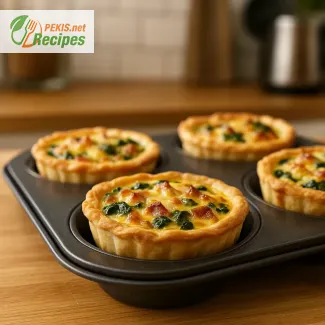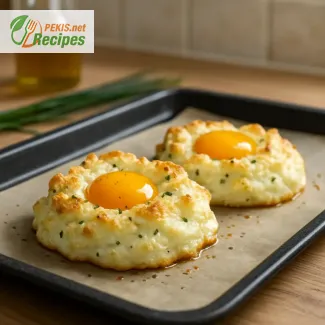Serves 4 portions with a prep time of 10 minutes, cook time of 12 minutes, and total time of 22 minutes. Magical egg shapes transform simple eggs into playful hearts, flowers, stars, and domes using plastic molds, no oil or butter needed. Mixed with colorful vegetables or small cubes of salami, they become light yet flavorful bites perfect for breakfast or party platters. Can be stored at room temperature for 2 days, frozen for 2 months, and reheated at 150 °C for 8–10 minutes.
PEKIS – professional chef and recipe developer with more than 25 years of experience in baking, specialized in European and international cuisine. For this recipe, I’ve worked with creative egg molds for many years, experimenting with ways to turn simple eggs into fun shapes that bring joy to both everyday breakfasts and festive gatherings.
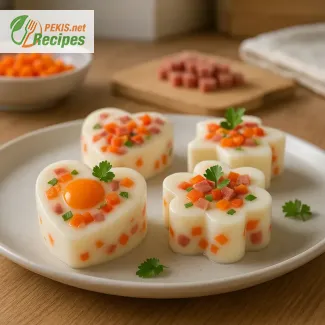
Creative ways to shape eggs into hearts, flowers, stars and domes
Transforming everyday eggs into playful culinary art
The beauty of shaped eggs lies in their simplicity. By cracking a fresh egg into a plastic mold, the liquid gently takes the outline of a heart, flower, star, or dome. Once cooked, the result is a delicate form that adds both charm and creativity to any meal. Unlike traditional frying or scrambling, this method requires no butter or oil, making it lighter while still keeping the creamy texture of the yolk and the smoothness of the white. A touch of finely chopped vegetables, herbs, or even small pieces of salami can be added to the mixture before closing the mold, bringing vibrant color and extra layers of flavor.
The idea of molded eggs has roots in Japanese and Korean bento culture, where decorative food preparation is a way of showing care and joy. Over time, this technique has spread worldwide, inspiring parents to create playful shapes for children’s lunches or food stylists to give brunch tables a unique visual appeal. What once was a simple boiled or fried egg can now become an eye-catching centerpiece, perfect for birthdays, picnics, or festive family breakfasts.
Why these magical egg shapes stand out
- No added fat – no butter or oil required.
- Playful design that makes meals more appealing for children.
- Versatile fillings such as vegetables, herbs, or charcuterie.
- Easy preparation with only molds and fresh eggs.
- Perfect for events, from breakfast platters to party buffets.
Texture and flavor combinations
Eggs cooked in molds preserve their silky consistency while offering opportunities to blend in different textures. Adding spinach or bell peppers introduces freshness and crunch, while grated cheese melts into a creamy core. For a savory twist, diced ham or salami brings richness, while fresh herbs like parsley or chives lift the aroma. Each shape offers a slightly different experience: hearts feel warm and symbolic, flowers celebrate springtime meals, stars brighten festive gatherings, and domes create an elegant, minimalistic look.
Storing and preparing ahead of time
- At room temperature: up to 2 days.
- In the freezer: up to 2 months.
- For reheating: place in an oven at 150 °C (300 °F) for 8–10 minutes until warm.
These options make molded eggs practical for busy mornings or when preparing ahead for a large family event.
Why you’ll love this recipe
- Quick to prepare with minimal tools.
- Attractive shapes make meals fun.
- Customizable with endless fillings.
- Works equally well for kids and adults.
- Ideal for breakfast, snacks, or party platters.
Creative variations for magical egg molds
- Vegetable rainbow – layer colorful vegetables such as carrots, peas, and bell peppers inside the mold for a multicolored effect.
- Cheese surprise – add a small cube of cheese to the center before cooking, letting it melt into a soft core.
- Herbal elegance – sprinkle chopped fresh herbs like dill, basil, or parsley into the egg mixture for a light and aromatic touch.
- Protein boost – mix in finely diced turkey, ham, or smoked salmon for a more filling version.
- Festive designs – dye the egg white with natural food coloring (spinach for green, beetroot for pink) before pouring it into the molds to match seasonal celebrations.
Culinary inspiration with shaped eggs
Shaped eggs can complement many meals: served on top of a crisp salad, tucked into sandwiches, or arranged on a platter as appetizers. Their playful forms also make them ideal for kids’ lunch boxes or as part of a brunch buffet where presentation matters as much as flavor. By combining the natural goodness of eggs with creative forms, you turn a staple ingredient into something memorable, bridging everyday cooking with a touch of artistry.
- Crack each egg into a bowl and whisk lightly until the yolk and white are combined but not fully beaten.
- Add a pinch of salt and black pepper to season.
- Mix in the diced carrot, bell pepper, and small cubes of salami.
- Prepare the plastic molds (heart, flower, star, dome) by rinsing them with water – no butter or oil is needed.
- Pour the egg mixture into each mold, filling up to about three-quarters full to allow slight expansion.
- Place the filled molds into a pot with gently boiling water and steam for about 10–12 minutes until the eggs are firm.
- Remove carefully, let cool for 2 minutes, then gently open the molds.
- Garnish with chopped parsley (for decoration) before serving.
FAQ questionDo I need oil or butter for these molds?
No. The mixture goes straight into plastic egg molds and sets without added fat. A quick rinse with cold water helps the egg slide in smoothly and prevents sticking, so the shapes keep their clean edges.
FAQ questionWhat’s the best way to cook shaped eggs—steam, boil, bake, or air fry?
The most reliable method is gentle steaming: place filled molds on a rack over simmering water for 10–12 minutes. Steaming cooks evenly, protects the shape, and avoids rubbery whites. You can also bake at 150 °C (300 °F) until set, or use an air fryer at low heat with the molds on a tray; just avoid high temperatures that cause bubbling and shrinkage.
FAQ questionHow can I keep the yolk centered or create a two-tone look?
For a centered yolk, don’t whisk—pour one whole egg per mold and keep the mold level. For a two-tone effect, lightly separate a tablespoon of whites, tint or season it, pour it in first, set for 1–2 minutes, then add the remaining egg so you get a defined outer ring and a tender core.
FAQ questionWhich add-ins work best and how small should they be?
Choose dry, finely diced ingredients—think bell pepper, carrot, parsley, chives, or tiny cubes of salami. Cut to 3–5 mm so they suspend evenly and don’t tear the shape. Avoid watery items (large tomato chunks, wet spinach) unless patted dry; excess moisture can create pockets and cracks.
FAQ questionHow do I unmold without breaking the shapes?
Let the molds rest 1–2 minutes, then run a thin stream of cold water over the outside to contract the plastic slightly. Open gently and push from the base. If any edge sticks, slide a silicone spatula or your fingertip around the seam—no knives, which can scar the mold and nick the egg.
FAQ questionCan I make them ahead and how should I store or reheat?
Cool quickly and refrigerate in an airtight box for up to 3 days, or freeze for 2 months with parchment between layers. Reheat on a tray at 150 °C (300 °F) for 8–10 minutes or briefly in a covered steamer. Add fresh herbs (for decoration) after reheating to keep their color and aroma.
Turning everyday eggs into playful shapes brings more than just taste to the table. The use of simple molds creates hearts, flowers, stars, and domes that instantly make a meal feel special. This approach is light, quick, and doesn’t require added fat, yet it delivers a dish that looks refined and fun at the same time.
The balance between creamy yolks, firm whites, and colorful add-ins like vegetables or salami makes these eggs both nutritious and satisfying. Their versatility means they can appear at breakfast, on a brunch platter, or as a decorative snack at family gatherings. Each shape tells its own story, from a heart for love to a star that sparks celebration.
Practicality also plays a role. These eggs can be stored for days, frozen for weeks, and quickly reheated without losing their form or flavor. That makes them ideal for busy mornings, meal prep, or festive occasions where presentation matters.
With minimal tools and just a few ingredients, it’s possible to elevate something ordinary into culinary art. The result is a dish that appeals to children and adults alike, combining ease of preparation with creative flair in every bite.
Allergens present in the recipe:
- Eggs
- Processed meat (salami contains additives and may contain traces of milk)
Gluten: Not naturally present in eggs or vegetables, but salami may contain gluten traces depending on processing.
Tips to avoid allergens and gluten:
- Replace salami with gluten-free turkey ham or smoked salmon.
- For a vegetarian option, add extra vegetables or tofu cubes instead of meat.
- To reduce sodium, skip salami and season only with fresh herbs.
- Vitamin A: 350 µg – supports eye health and immune system.
- Vitamin B12: 1.2 µg – essential for nervous system function.
- Vitamin D: 1.5 µg – important for bone strength and calcium absorption.
- Iron: 1.2 mg – helps transport oxygen in blood.
- Calcium: 35 mg – contributes to bone density.
- Potassium: 150 mg – regulates fluid balance and muscle function.
- Beta-carotene (from carrot and bell pepper): 1.1 mg – protects cells from oxidative stress.
- Vitamin C (from bell pepper): 25 mg – strengthens immunity and skin health.
- Lycopene (from red pepper): 0.5 mg – supports heart health and reduces inflammation.

